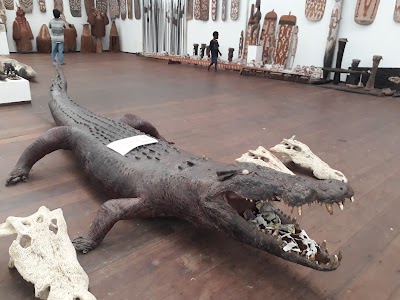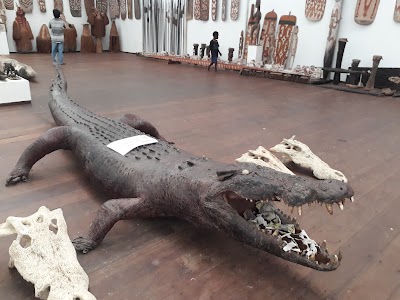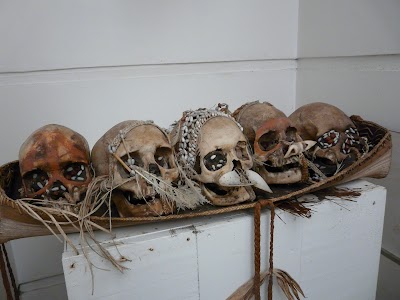Asmat Museum of Culture and Progress (Museum Asmat)
Overview
The Asmat Museum of Culture and Progress, located in Papua Barat, Indonesia, offers a captivating insight into the rich cultural heritage of the Asmat people, an indigenous community renowned for their exquisite woodcarving skills and profound spiritual connection to their environment. For foreign tourists seeking an authentic cultural experience, this museum serves as a treasure trove of history, art, and tradition.
The museum's history dates back to its establishment in the late 20th century, founded as both a cultural preservation hub and a beacon of progress for the Asmat community. Spearheaded by Father Frank A. Trenkenschuh, a dedicated missionary, the museum was envisioned as a place to showcase and preserve the unique artistic talents and cultural practices of the Asmat for future generations. His dream came to fruition when the museum opened its doors, providing locals and visitors alike with profound insights into the Asmat way of life.
One of the museum's most compelling features is its extensive collection of wood carvings. The Asmat people are globally celebrated for their intricate carvings, which serve not only as art but also as vital expressions of their culture, imbued with spiritual significance. Visitors can marvel at a diverse array of artifacts, including intricately carved shields, ancestor poles known as bisj poles, and ceremonial masks. Each piece tells a unique story, often depicting ancestral legends, spiritual beliefs, and social structures, offering an immersive experience into the Asmat cosmos.
In addition to wood carvings, the museum showcases an impressive array of cultural artifacts. Traditional Asmat tools, weapons, and ceremonial items provide a comprehensive glimpse into daily life and customs. The collection also features textiles and traditional clothing, highlighting the intricate craftsmanship and vibrant aesthetics of Asmat weaving and adornment.
Notably, the museum transcends being a static display; it actively engages in the cultural and social development of the Asmat community. Regular workshops and demonstrations allow visitors to witness the craftsmanship of Asmat artisans firsthand. These interactive sessions offer a unique opportunity to learn about the techniques and meanings behind the carvings and other traditional crafts, enriching the visitor experience.
A standout section of the museum is dedicated to the progress and contemporary life of the Asmat people. This exhibit emphasizes the dynamic nature of Asmat culture, illustrating how traditional practices are being adapted in the modern world while retaining their cultural essence. This aspect underscores the theme of progress within the community, reflecting the resilience and adaptability of the Asmat in a rapidly changing environment.
Situated in Agats, the capital of the Asmat Regency, the museum's location adds to its charm. Agats is a unique settlement built entirely on wooden stilts over swampy ground, connected by a network of wooden boardwalks. The town itself is a marvel of indigenous engineering, offering additional exploration opportunities for tourists eager to understand how the Asmat people have harmoniously adapted to their environment.
For those planning a visit, it's reassuring to know that the museum is equipped with modern facilities to enhance the visitor experience. Guided tours are available in multiple languages, providing insightful narratives and deeper understanding of the exhibits. Additionally, the museum shop offers authentic Asmat carvings and crafts, allowing visitors to take a piece of Asmat heritage home with them.
The Asmat Museum of Culture and Progress stands as a testament to the enduring spirit and creativity of the Asmat people. It is a place where ancient traditions and modern aspirations converge, offering an unparalleled cultural experience for all who visit. Whether you are an art enthusiast, a history buff, or a curious traveler, the museum promises to leave you with a deeper appreciation of the Asmat's rich cultural tapestry and a lasting impression of their remarkable journey.
In conclusion, the Asmat Museum of Culture and Progress is more than just a museum; it serves as a vibrant cultural center that celebrates the past, present, and future of the Asmat people. Its diverse collection of artifacts, dynamic exhibits, and educational initiatives make it a must-visit destination for anyone traveling to Papua Barat, Indonesia. As you stroll through its halls, you will not only witness the artistic brilliance of the Asmat but also gain valuable insight into their profound connection with the world around them.







